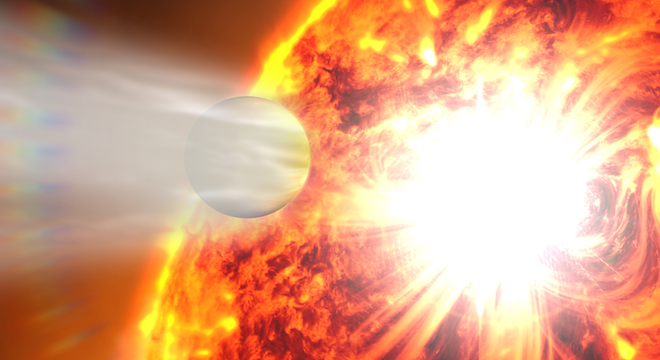As we’ve said before: As hot as it may be outside, it could be worse. Earth could be much closer to the Sun, for example — so close that our atmosphere would actually boil off.
That’s exactly the fate that is occurring to another planet outside our solar system, as European astronomers recently discovered using NASA’s Hubble Space Telescope.
The expolanet, HD 189733b, is a gas giant similar to Jupiter but located 63 light-years away from Earth.
That’s actually relatively close, in a cosmic sense: The star that the planet orbits, located in the constellation Vulpecula near the Dumbbell Nebula, can be viewed from the ground on Earth using just a pair of binoculars, according to NASA.
But using a much more powerful looking glass, the Hubble Space Telescope, and peering at the planet over a two-year stretch in 2010 and 2011, French astronomer Alain Lecavelier des Etangs and his colleagues were able to see something never before spotted in astronomical history: The atmosphere of the planet actually streaming off into space at speeds in excess of 300,000 miles-per-hour.
Check out the following video simulation of the planet’s atmosphere evaporating from NASA:
“We hadn’t just confirmed that some planets’ atmospheres evaporate,” Lecavelier said in a statement on the European Space Agency (ESA) website, “We had watched the physical conditions in the evaporating atmosphere vary over time. Nobody had done that before.”
Actually, when the first looked at HD 189733b back in 2010, Lecavelier said that he and his team were “disappointed” because there was no observable atmosphere on the planet, and thus no atmospheric conditions for them to study.
But when they followed up in 2011, they saw something unprecedented: A plume of atmospheric gas blowing off the planet at a rate of 1,000 tons per second, giving the planet a “comet-like” tail.
Hubble was able to see the gas cloud as the planet passed in front of its parent star, allowing some of the light from the star to penetrate the planet’s atmosphere, allowing scientists to better observe and understand its composition.
In fact, the planet HD 189733b orbits so closely to its star — just 3 million miles away, or 30 times closer than the Earth is to the Sun — that the length of its “year,” or one complete orbit around the star, is just 2.2 Earth days.
And so although the star is smaller than our Sun, about 80 percent of its size, and cooler, the planet’s close proximity puts it in a precarious position, with its atmosphere being heated to 1,900 degrees Fahrenheit, according to NASA.
That alone isn’t hot enough to cause the atmosphere to boil off, though. Instead, Lecavelier and his colleagues have concluded that its actually the extremely high dose of X-ray and ultraviolet radiation that the star is blasting at its close-by planet — 3 million times what Earth receives from our Sun — which causes the planet’s atmosphere to heat to the point where it actually dissipates into space.
It was just the European astronomy team’s good fortune that just hours before Hubble was scheduled to be observing the planet again in late 2011, another another space telescope, NASA’s X-ray observing Swift, caught its parent star releasing a huge flare, which bathed the planet in 3.6 times the number of X-rays it ordinarily receives.
“It seems very likely that the impact of this flare on the planet drove the evaporation seen a few hours later with Hubble,” said Peter Wheatley, a scientist at the University of Warwick, UK, who was also part of the team that made the discovery, in a statement on the ESA website.
Scientists still aren’t sure whether the vanishing atmosphere of HD 189733b was just a one time event or is actually a recurring phenomena that can be charted with any regularity, such as the Sun’s 11-year sunspot activity cycle. But they plan to do further study on the boiling planet using Hubble and ESA’s XMM-Newton X-ray space telescope.
For now, the team will publish its initial findings in the journal Astronomy & Astrophysics.






